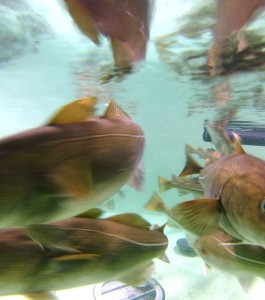May 8th, 2014, By Eva Tallaksen, undercurrentnews.com
 Scientists in Tromso, Norway, are exposing cod broodstock to high CO2 to find out how the fish will cope as the seas get warmer, and more acidic.
Scientists in Tromso, Norway, are exposing cod broodstock to high CO2 to find out how the fish will cope as the seas get warmer, and more acidic.
“The idea is to find out, how will ocean acidification affect aquaculture and wild fish?” said Christopher Bridges, zoology professor at the university of Dusseldorf.
It is hoped larvae scooped from five tanks at Nofima’s national cod breeding center will soon yield some clues.
Each tank contained 60 cod broodstock averaging 3-5 kilos in size, exposed to different levels of temperatures and acidity. The fish spawned March and April, and their larvae, which hatched in the past two weeks, are currently being tested.
“The key aspect will be to look at the larvae’s survival rate,” said Bridges.
If global warming continues as some scientists think, the oceans’ CO2 levels could reach 1,000 to 1,200 ppm (parts per million) by 2100, up from just under 400ppm today.
That would take the seas’ pH level down to 7.8, from 8.1 today.
Most the research into the seas’ growing acidity has focused on the impact on fish eggs or larvae, or on habitats. But few have so far focused on its impact on broodstock, said Bridges.
Bridges is one of the scientists involved in the project, which is led by the publicly-funded German Bioacid initiative. Cooperating in the project are Germany’s Geomar and Alfred Wegner Institute, working in Norway under the EU FP7 support project Aquaexcel using the facilities of Nofima.
In two of the tanks, the cod were kept at normal acidity levels (400ppm), but one tank had a temperature of 5 degrees Celcius, and the other 10 degrees. In two other tanks, the fish were exposed to CO2 levels of 1,200 ppm, again with one tank at 5 degrees and the other at 10 degrees.
These four tanks all used broodstock from farmed fish, bred by Nofima’s center. A fifth tank was filled with fish from the wild, but these were caught too late to be used for the experiment.
Read more here
